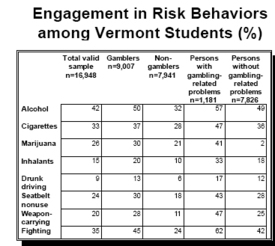The nature of the relationship between gambling and other risk behaviors has been the subject of a sizable body of research. Numerous aspects have been investigated from the neurobiology of risk-seeking to personality traits associated with particular risky behaviors. Proimos, DuRant, Pierce, and Goodman (1998) recently published a paper that sets out to contribute to this literature. In 1995, the Vermont Youth Risk Behavior Survey was administered to Vermont students in grades eight through twelve. The survey consisted of 91 questions, and was given on a voluntary and anonymous basis to all students who were present on a particular school day. Among the questions concerning risk behaviors were two gambling-related items. The first question was intended to establish a past-year prevalence rate for any gambling activity. The second asked respondents whether they had experienced any secondary problems as a result of their gambling. The authors took the data set collected from this survey and analyzed it to discern possible relationships between the answers provided to these two questions and the responses to questions about other risk behaviors. Of the 21,297 responses, 16,948 were valid for this analysis. The table below lists the prevalence rates of selected risk behaviors among respondents answering the two gambling-related questions. It should be noted that the question concerning gambling problems refers not to problem gambling in the diagnostic sense but pertains rather to secondary personal or social difficulties encountered as a result of gambling behavior. The authors of the present study distilled their findings using a composite risk behavior index, based on the number of positive responses to questions concerning 13 risk behaviors. Scores ranged from 0 to 13,
the latter indicating participation in all listed risks. For non-gamblers, the mean score was computed to be 2.2 (SD=2.2). Gamblers reporting no gambling-related problems scored an average of 3.5 (SD=2.7), while gamblers with gambling-related problems scored a mean of 5.1 (SD=3.4). The differences between these scores are statistically discernible at p<.0001. Such findings suggest a correlation between the positive responses to the two gambling-related questions included in the instrument and participation in other risky activities. But caution must be used. Vermont is a state with an unusually low minority population, a characteristic that immediately limits the study’s representativeness of the general American population. The authors also consider the possibility that a significant proportion of youths in the category most disposed to risky behaviors may have dropped out of school, thus excluding them from the sample. In addition, the gambling-related questions limited the number of dependent variables available for analysis to two. Similarly, the design of the questions themselves make comparison to more standard measures nearly impossible. Nevertheless, the study provides evidence to further the proposed correlation between gambling and engaging in other risky activities.
Source: Proimos, J., DuRant, R.H., Pierce, J.D., & Goodman, E. (1998). Gambling and other risk behaviors among 8th- to 12th grade students. Pediatrics, 102(2). (online edition www,pediatrics.org/cgi/content/full/102/2/e23)
This public education project is funded, in part, by The Andrews Foundation and the National Center for Responsible Gaming.
This fax may be copied without permission. Please cite The WAGER as the source.
For more information contact the Massachusetts Council on Compulsive Gambling,
190 High Street, Suite 6, Boston, MA 02110, U.S.





